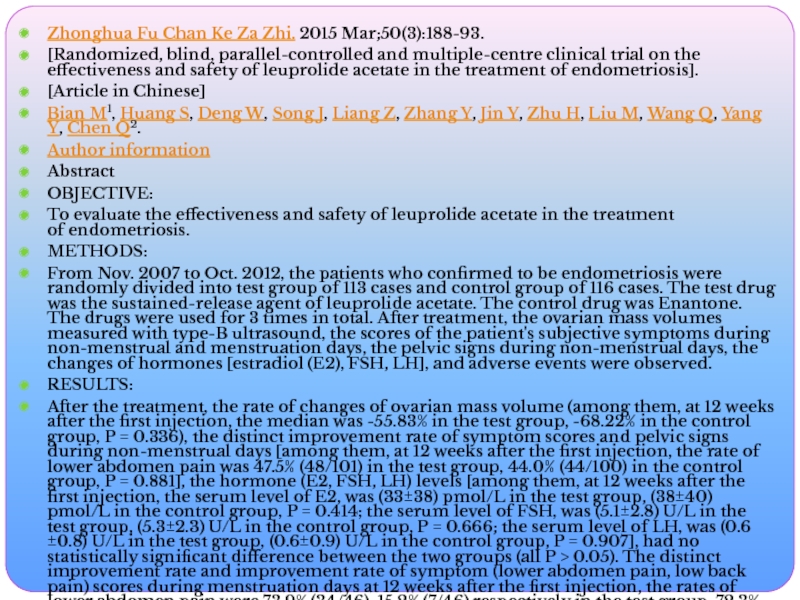Слайд 10Қосу критерийі:
Толық зерттеуден өткен,диагнозы дәлелденген науқастар (қынаптық зерттеу ( 5-7
и 18-22 күні д.м.ц.,) кіші жамбас УДЗ ( 5-7 и 18-22 күні д.м.ц.),кольпоскопия (5-7 и 18-22 күні д.м.ц.),гистероскопия 5-7 күні менструальды циклдің, вирусты гепатит В, Сифилис, ВИЧ)
Осы ауру барысында жүктіліктің жоқ болуы
Эндометриоздың 3-4 сатысындағы науқастар
Гормональды препараттарға аллергиялық реакциясы жоқ науқастар
Репродуктивті жастағы науқастар
Генитальды эндометриозбен науқастар
Слайд 12Этикалық аспектілері:
1. Қауіп төндірмеу (primum non nocere);
2. Ақпараттық келісім алынды міндетті
түрде.
3. ақпараттық келісім, қажетті ақпаратты толық ашылып, адекватты және түсінікті құрылымда түсіндірілді;
4. Науқастың зерттеудің кез келген сатысында өз еркімен қатысудан бас тарту құқығы айтылды
5. Науқастарға қоғамға пайдалылық, шығынның аздығы, пайданың қауіптен жоғары болуы түсіндірілді.
6. Әділеттілік сақталды: зерттеуге ешбір қатысушы өз ырқынан тыс,біреудің мәжбүрлігінсіз кездейсоқ таңдап алынды
7.Этикалық комитетпен рұқсат етілді
Слайд 15
Zhonghua Fu Chan Ke Za Zhi. 2015 Mar;50(3):188-93.
[Randomized, blind, parallel-controlled and multiple-centre clinical
trial on the effectiveness and safety of leuprolide acetate in the treatment of endometriosis].
[Article in Chinese]
Bian M1, Huang S, Deng W, Song J, Liang Z, Zhang Y, Jin Y, Zhu H, Liu M, Wang Q, Yang Y, Chen Q2.
Author information
Abstract
OBJECTIVE:
To evaluate the effectiveness and safety of leuprolide acetate in the treatment of endometriosis.
METHODS:
From Nov. 2007 to Oct. 2012, the patients who confirmed to be endometriosis were randomly divided into test group of 113 cases and control group of 116 cases. The test drug was the sustained-release agent of leuprolide acetate. The control drug was Enantone. The drugs were used for 3 times in total. After treatment, the ovarian mass volumes measured with type-B ultrasound, the scores of the patient's subjective symptoms during non-menstrual and menstruation days, the pelvic signs during non-menstrual days, the changes of hormones [estradiol (E2), FSH, LH], and adverse events were observed.
RESULTS:
After the treatment, the rate of changes of ovarian mass volume (among them, at 12 weeks after the first injection, the median was -55.83% in the test group, -68.22% in the control group, P = 0.336), the distinct improvement rate of symptom scores and pelvic signs during non-menstrual days [among them, at 12 weeks after the first injection, the rate of lower abdomen pain was 47.5% (48/101) in the test group, 44.0% (44/100) in the control group, P = 0.881], the hormone (E2, FSH, LH) levels [among them, at 12 weeks after the first injection, the serum level of E2, was (33±38) pmol/L in the test group, (38±40) pmol/L in the control group, P = 0.414; the serum level of FSH, was (5.1±2.8) U/L in the test group, (5.3±2.3) U/L in the control group, P = 0.666; the serum level of LH, was (0.6±0.8) U/L in the test group, (0.6±0.9) U/L in the control group, P = 0.907], had no statistically significant difference between the two groups (all P > 0.05). The distinct improvement rate and improvement rate of symptom (lower abdomen pain, low back pain) scores during menstruation days at 12 weeks after the first injection, the rates of lower abdomen pain were 73.9% (34/46), 15.2% (7/46) respectively in the test group, 72.3% (34/47), 2.1% (1/47) respectively in the control group, had statistically significant difference between the two groups (P = 0.026). There was no serious adverse event occurred in both two groups. The incidence rate of adverse event was 33.6% (38/113) in test group, 23.2% (27/116) in control group, there was no significant difference between the two groups (P = 0.082).
